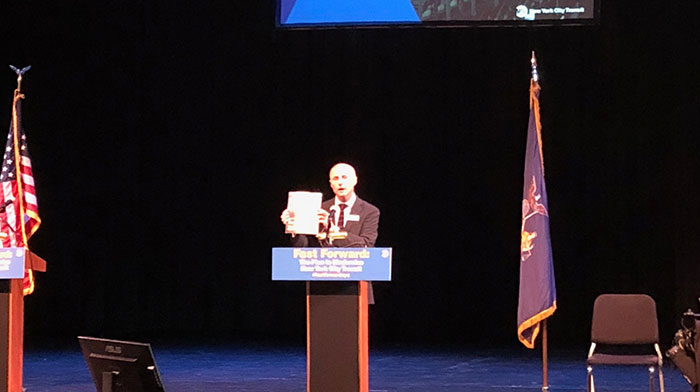Forum Photo by Michael V. Cusenza
New York City Transit President Andy Byford on Tuesday touts the “Fast Forward” plan at York College.
By Michael V. Cusenza
Moments after riding the J line to York College’s Milton G. Bassin Performing Arts Center, New York City Transit President Andy Byford openly yearned for the day when the ancient R42 iron horse that carried him to Jamaica Tuesday evening is finally put out to pasture.
“It belongs on the scrap heap,” Byford deadpanned.
According to his recently released strategy to modernize the Metropolitan Transportation Authority subway and bus system, which he detailed and discussed on Tuesday at the agency’s first Fast Forward Plan town hall meeting, in just five years the scrap heap is exactly where you’ll find elderly R42s—and the previous manner in which the MTA served the city.
“I want to transform the culture so that it’s customer-led. Everything we do is with you in mind,” an ebullient Byford said at the event that seemed to be equal parts intervention and promotion. “This is no mere tweak. Fast Forward is designed to turn around transit in this city—but it won’t be cheap and it won’t be easy. It’s a comprehensive modernization from top to bottom.”
And this operation is in desperate need of an overhaul, Byford said.
“The stark reality is that this great system finds itself in a state of emergency,” he added.
The role model for this revolution? The London Underground, according to Byford the Brit. He noted that the Tube was in a similar state of apocalyptic disarray 20 years ago. Now, it’s one of the best systems in the world.
Highlights the 75-page Fast Forward blueprint:
• State-of-the-art signal and track infrastructure: Within five years, the latest computerized signal and track infrastructure will be installed on five additional lines, so three million daily riders are on lines with Communications Based Train Control. This work will also require the refurbishment, replacement or upgrading of myriad supporting infrastructure and equipment such as power systems, shops and yards, and cars.
• Accelerated work towards a fully accessible subway system: Within five years, more than 50 new stations will be made accessible, ensuring that all subway riders will not be more than two stops away from an accessible station.
• A state-of-the-art fleet of new subway cars and buses: Within five years, riders will be benefit from more than 650 new subway cars, more than 1,200 refurbished cars, and 2,800 new buses including 200 electric buses. Byford said that he has expressed a desire to achieve a fully electric bus fleet.
• A completely redesigned bus route network: The entire route network for local and express buses in the five boroughs is being re-evaluated and redesigned based on ridership patterns, road operating conditions and input from customers, route neighbors, advocates and others.
• Improving customer service and communication: The plan includes a new “Strategy and Customer Experience” division to ensure the interests of customers are considered in all decisions. Improvements include performance tracking dashboards, train and bus arrival info, wayfinders and roaming station agents. Within the next five years, screens will be installed in all stations and on more than 3,000 subway cars to provide real-time location-specific information, as well as a new mobile-friendly website and app launching this year. The quality assurance of public address systems in stations, on subway cars and on buses will be strengthened, Byford promised.

